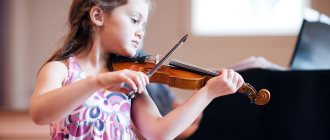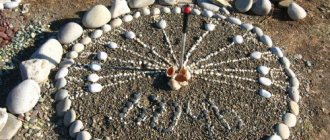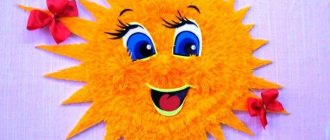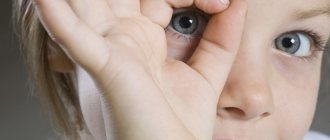Maria Savchenko
Experimental activities in the preparatory group. How to create a rainbow
Introduction
Every person at least once in his life admired a natural miracle - a rainbow . Many people have probably noticed that rainbows usually appear after rain. a rainbow many times , I wanted to know what a rainbow and how it appears, whether it is possible to get a rainbow artificially at home.
Purpose of the study: to find out whether it is possible to get a rainbow at home .
The object of study is the natural phenomenon of the rainbow .
The subject of the study is the types of rainbows and the possibility of obtaining them artificially.
Research problem: how to create different types of rainbows at home ?
Research objectives:
1. Find out what a rainbow and how it appears.
2. what types of rainbows exist in nature and is it possible to obtain them artificially?
3. Conduct experiments on obtaining a rainbow at home .
Hypothesis:
Let's assume that a rainbow can be obtained by replacing the sun's rays:
1. artificial light - lamp,
2. using water and felt-tip pens.
3. using Skitels
I have chosen will allow you to see a rainbow at home .
Basic methods: literature study, observation, experiment.
1.Relevance:
How does a rainbow ?
Since my senior year I have known the saying “Every hunter wants to know where the pheasant sits. From the initial letters of these sayings, I remembered the names and sequence of colors of such an unusual and beautiful natural phenomenon as a rainbow . Why does such a beautiful, and even colorful, picture appear in the air? Together with my teacher, we looked for the answer to this question in the encyclopedia, the Internet, and watched educational cartoons about rainbows . We learned that rainbows can be seen near waterfalls, fountains, and sprinklers.
Conclusion: a rainbow appears in sunny weather during rain, when the sun's rays pass through raindrops.
2. What types of rainbows exist .
a rainbow in the encyclopedia , I decided to find out what other rainbows exist .
A winter rainbow is a very rare phenomenon, because the refraction of sunlight occurs not in water droplets, but in ice crystals.
Hazy or white rainbow
It appears when a faint fog consisting of small droplets is illuminated by sunlight.
Red rainbow
In the last five or ten minutes before sunset, all the colors of the rainbow except red begin to disappear and finally only a single red arc remains.
Practical part
Rainbow is a miracle of nature . Is it possible to create this miracle yourself , at home? I decided to try this and conducted several experiments together with my teacher.
Experience No. 1 “ Creating a rainbow at home ”
Experiment No. 1: “Walking” water
To get started, you will need a set of the following materials:
Five transparent glasses of the same height (plastic cups will do);
Paper towels (napkins);
Water (tap);
Food coloring (three colors);
1. Have your child fill three cups with water and have them add coloring to each one;
2. Place an empty glass between two filled with colored water;
Ask your child if he knows what gravity is? If he doesn't already know this, explain that gravity is the force that attracts objects to each other. In this experiment, gravity will help the water move faster into an empty container.
3. Help your child fold the paper towel in half several times to create a long, thin strip about 2-3 cm wide. Repeat with the other paper towel (napkin) again;
4. Ask him to dip one end of a paper towel strip into a container of colored water and place the other end of the strip into an empty glass. Thus, the dry edges of two paper towels should fit into the dry cup.
All you have to do is wait - the water will begin to flow into the empty container within a few minutes; While you wait, make some predictions with your child: Will the water actually flow and how long will it take? What happens when you put two different colors together?
In a couple of hours you will see much more impressive results.
YouTube
Preparatory stage
To conduct the “Rainbow in a Glass” experiment in kindergarten, the teacher can learn a rhyme with the group that helps them remember the order of the colors of the rainbow. This will be the main spell. Let the kids taste the water, decide what color it is, add a little color and mix. They will see that the liquid completely changes color. Experimentation will teach children to be careful when handling water, develop fine motor skills and reasoning skills.
What will you need for the experiment?
To demonstrate the Rainbow in a Glass experiment for preschoolers, some simple preparations are required. Each participant must have the following set on the table:
- granulated sugar or salt, about 0.5 kg;
- 6 plastic cups (more is possible);
- food coloring or gouache 5 colors;
- warm water;
- syringe without needle;
- napkin and sheet of thick cardboard;
- colored markers;
- small mirror;
- flashlight.
Children may need help mixing ingredients carefully and maintaining proper proportions.
Experiment No. 2: Visually about the density of matter
An even simpler experiment in which you will need:
Transparent container (glass or jar);
Food coloring;
Liquids of different densities - for example, honey, vegetable oil, liquid soap, glycerin, water, alcohol, milk, and so on;
And also small objects: some kind of steel bolt, a piece of glass, rubber and, for example, paraffin.
1. We tint colorless liquids using dye;
2. We take a glass and carefully pour denser liquids into it first - for example, honey, milk, liquid soap, water, vegetable oil, motor oil, alcohol, and so on. Try to do this with your child so that he has an interest in participating in the process;
3. Carefully, without shaking or mixing the liquid, lower various objects into the container. Since their density is also different, they will be distributed on the surfaces of different liquids.
Ta-dam! This experiment will clearly show what the density of matter is.
YouTube
IMPORTANT! If you pour substances not intended for human consumption into the container, we throw it away after the experiment so that no one accidentally drinks from it afterwards.
see also
Production of liquefied argon, interaction of cesium with water and other fascinating video experiments
Description of the experience
For many experiments, ingredients that are found in any home are enough. Rainbow in a glass is an experience for children that will introduce them to the properties of water. This theme combines three different experiences that can be carried out in a kindergarten group or at home. They do not require special devices or reagents, and the participants will love the multi-colored result of the trick. The first experiment reveals the concept of water density, the second - the absorbency of paper, and the third - the refraction of light.
A description of the “Rainbow in a Glass” experiment for children can be found in video format; its preparation requires a little time and gouache or food coloring of several colors.
Experiment No. 3: “Slowing the Fall”
No less simple, but such a cool, almost “magical” experiment!
For it we will need:
Copper thick-walled tube with a hole diameter of 2-3 cm;
A neodymium magnet, whose outer diameter should be a couple of millimeters smaller than the inner diameter of the tube.
Attention! Despite the only two elements required for the experiment, getting them will not be so easy, but you will definitely like the result, and your child will simply be delighted with it!
1. To begin with, we demonstratively drop the magnet without the tube. It will fall, like any other object, to the floor in a split second;
2. Now we take our metal blank and throw a magnet into it, like this:
YouTube
A beauty, isn't it? We are sure that your child will instantly want to play with a new toy, regardless of age, 4, 5, 10 years or more. Give him this opportunity.
Explaining from a textbook that a falling magnet changes the magnetic flux in the pipe in such a way that it induces (induces) an electric current, the direction of which is determined by Lenz's rule, which in turn generates a magnetic field, will most likely be too early (and even then if you are in you figure this out yourself), but you will most likely be able to amaze a child and, perhaps, give him a desire to engage in interesting, entertaining science.
Experiment No. 4: “Newton’s Cradle with your own hands”
For the experiment you will need:
Three bottles of the same volume filled with water (half a liter will be enough);
Ball, ball (not very big, but massive enough that it could knock down one bottle like a pin).
The experiment has begun!
1. We place the skittle bottles one after another;
2. We launch the ball into the bottle. Having done this, you will see that the last bottle in the row will fall.
Before you let your child have fun with physics, briefly explain to him that this is called Newton’s cradle (pendulum) effect, which demonstrates to us the transformation of energy of different types into each other: kinetic into potential and vice versa.
adme.ru
see also
Two methods for making homemade invisible ink: one tested (works)
Experiment No. 5: Making a transparent egg shell
From physical experiments to chemical experiments.
You will need:
A raw egg;
Table vinegar.
The experiment is quite long (from a day to two), but the end result, we are sure, is worth it!
1. Pour vinegar into a container. It is advisable to use 9 percent vinegar;
2. We immerse the whole egg in the liquid so that the shell is completely hidden under its level;
3. We wait a day or two.
The point of the experiment is that vinegar will eat away the calcium that makes up the shell, leaving only the inner film between the protein and the shell. In this case, the protein itself will thicken from interaction with vinegar.
It is interesting that calcium carbonate, of which the shell is mainly composed, will begin to release carbon dioxide as it disintegrates. You can also tell your child about this. It's interesting and educational!
Attention! Eggs should not be eaten! You've seen what vinegar does to protein...
[media=
https://youtu.be/7VhsyMU_8UU
]
YouTube
Here are more advanced experiments with chicken eggs:
YouTube
Experiment No. 6: Creating a Rainbow Arc
Experiment kit:
Tray:
Mirror;
Water;
Flashlight;
A piece of white paper.
1. Fill the tray halfway with water;
2. We immerse the mirror in it as shown in the photo below, but you can do it completely:
center-sozvezdie.ru
3. Place a sheet of white paper on the opposite side;
4. We direct the turned on flashlight at the mirror so that the reflected light hits the paper. And here it is - RAINBOW!
YouTube
This is how dispersion occurs - the decomposition of white light into a spectrum (rainbow). After such a visual and colorful experience, a 5th or 6th grade student, if you explain to him what dispersion is, will most likely even remember this concept even before starting the physics course.
see also
20 photos showing the beauty of the world found in simple things
Abstract of OOD "RADUGA - DUGA"
Summary of a lesson on cognitive and research activities for preschoolers “RAINBOW - ARC”
Educator: Sesoreva M.A.
Target:
Development of children's research abilities, consolidation of knowledge about the colors of the rainbow.
Objectives:
• Improve the ability to observe and analyze objects of the surrounding world;
• Develop a desire to participate in creative activities; • To cultivate a positive emotional and value-based attitude towards the world around us, Plan:
1. Conversation “Fairytale Rainbow” 2. Learning the acrostic phrase “Every Hunter...” 3. Experience-experiment “Rainbow on a disk” 4. Drawing “Flower - seven-colored” 5 .Reading: “The Legend of a Boy Named Rainbow”
Lesson progress: MORNING 1. CONVERSATION “A FANTASTIC RAINBOW”
The rainbow is one of the most fabulous phenomena of nature. Rainbow is
companion of the rain. A rainbow can appear before the rain, during the rain, and after the rain stops.
What is a rainbow? A rainbow is an arc of color. It can be seen against the background of the rain. A rainbow is observed in the side of the sky that is opposite to the sun, while the sun is not covered by clouds. Most often, such conditions are created in the summer, during the so-called “mushroom” rains. There are seven colors in the rainbow. - Where else besides the sky can you see a rainbow? (children's answers)
— A rainbow can be seen near a fountain or waterfall, against the background of drops from a sprinkler.
A rainbow can be seen at a time when the Sun is shining in parallel with the rain. To see it, you need to be strictly between the Sun and the rain. In this case, the Sun should be behind, and the rain should be in front. —Where does the amazing colorful light emanating from a rainbow come from? The source of the rainbow is sunlight. This light moves across the sky in such a way that it appears to come from that part of the sky that is opposite to the Sun. 2. LEARNING THE ACROSTIC PHRASE “EVERY HUNTER...”
Everyone is Red;
Hunter - Orange; Wishes - Yellow; Know - Green; Where - Blue; Sitting - Blue; Pheasant - Purple. 3. EXPERIMENT “RAINBOW IN A GLASS” (using a CD)
- Take the CD and wipe it so that it is not dusty.
- Place it on a flat surface, under a light or in front of a window. - Look at the disk and enjoy the rainbow. You can spin the dial to see how the colors move. 4. DRAWING “FLOWER – SEMIFLOWER
5.READING:
"The LEGEND OF A BOY NAMED RAINBOW"
This happened in the old, old days. At that time there was only one large island on Earth in the middle of the ocean. And colorful people lived on this island. They did not have a school, so they were all ill-mannered, greedy and evil. Multi-colored people constantly argued with each other, were mischievous, and called names. One day a boy with silver skin and golden hair appeared on this island. His name was Rainbow. He was the son of the Sun and Cloud. Rainbow always looked down on people and really wanted to get to know them. He didn't know what they really were. Multi-colored people seemed very beautiful, cheerful and friendly to him. The boy spent a long time trying to persuade his parents to let him go to Earth. And finally, he received permission and found himself on the island among people. He happily walked down the street and said hello to everyone he met. But in response, people were rude to him, teased him and laughed evilly. The rainbow came to a large area. There were a lot of colorful people here. And all of them, as always, shouted and called names, some even fought. The boy was very upset. Now people seemed scary, crooked and evil to him. Rainbow wanted to run away, to return home to her parents. But he was a very kind boy and decided to reconcile all the colorful people. “They need to see themselves from the outside, how scary and ugly they are,” thought Rainbow. “But how to do this?” In those days there was no mirror on Earth. Then the boy came up with the idea: “We need to draw them!” But Rainbow did not yet know how to draw large pictures, and the only artist on the island did not agree to teach him. But Rainbow did not give up. Every day he began to go to the garden, where the only artist painted his paintings. The boy hid in the bushes and carefully watched the work of the only artist. Then Rainbow took the brushes and paints that he begged from his Aunt Nature and tried to paint. That's how I learned. Time passed. And then one day Rainbow woke up and realized that he was ready to paint his picture. He worked for a long time. I walked the streets, observed and drew, observed and drew. And now, the picture is ready! Rainbow installed it in the largest area and covered it with a black blanket until the morning. And he went to bed. But the colorful people did not sleep that night. They have long wanted to somehow harm this good-natured Rainbow. And so, when the picture appeared on the square, they came up with a cruel joke. Multi-colored people made their way into the square, pulled the black cover off the painting and poured black paint on it. They were so busy with their villainy that they did not even look at what was painted in the picture. In the morning Rainbow ran to the square and wanted to remove the black cover from the painting. But it was not filmed. The boy was surprised, but then he realized what had happened and began to cry. And colorful people stood around and laughed. Then they started spraying him with colorful paints. Everything was dirty. Rainbow could not stand this and asked his parents to take him home. At home, Rainbow washed off all the paint, but he couldn’t wash his hair. So they remained colorful. Then the boy told his parents everything and asked his mother Tuchka to wash off the black paint from the picture, and his father Sun to illuminate the picture brightly. Let colorful people look at themselves from the outside. Mom Cloud and dad Sun fulfilled their son’s request. The colorful people were still in the square. They screamed and argued, fought and bit. And they didn’t even notice how Tuchka’s mother came and washed off the black paint from the painting with the rain. But then Father Sun appeared and illuminated his son’s picture brightly. The noise slowly began to subside. And suddenly all the colorful people turned red. Everyone saw themselves in the picture. And they all felt very, very ashamed. Everyone stood and was silent. Then Father Sun decided that colorful people were too different from each other. It will be better if they become one color. It began to shine brighter and brighter, burning people and tanning them. But some people stood in the very sun and became dark brown, others were in the shade and their skin became white, and others became yellowish. This is how three races appeared on Earth: blacks, Europeans and Mongols. But the Sun not only repainted people, but also made their hearts warm and kind. Since then, all people on Earth have become friends. Then the only large island was divided into several islands, but the friendship between such different people does not stop. And every time when mother Cloud washes the Earth, and father Sun illuminates it, the boy Rainbow looks at people, so different, but friendly and happy, and rejoices. And with joy, his hair begins to shimmer with multi-colored colors, and a rainbow appears in the sky.
Experiment No. 8: “Non-Newtonian fluid” at home
For the experiment you will need:
container (for example, tray);
starch;
water;
dye.
1. Pour the starch into a container;
2. Mix with water in a ratio of 2 to 1 (according to other sources, the proportion should be 1 to 1). That is, there should be half as much water as starch (as shown in the video below);
3. Mix thoroughly to obtain a homogeneous thick mixture. If necessary, add more starch for thickness;
4. Add dyes (optional, this will not affect the quality of the non-Newtonian liquid)
YouTube
Normally, in a container, the liquid will look like water and behave as such, but if you apply force to it, for example, sharply squeezing your palm while immersed in it, you will feel solid pieces. Between the fingers. Or, as in the experiment above, upon impact the liquid becomes very viscous, almost solid.
YouTube
Attention! Do not let your child beat the non-Newtonian liquid with his hand, only with some object, such as a pestle, to avoid injury.
see also
How to learn to juggle, and where to start?
How to explain "Rainbow" to preschoolers
An interesting lesson should be completed by explaining the properties of water. The teacher can tell the children that the denser the material - paper compared to a napkin - the slower it gets wet. Therefore, the dots from felt-tip pens take longer to spread.
The description of the “Rainbow in a Glass” experiment for children in the second version includes the following explanation: light consists of a full spectrum of colors, and with the help of a mirror it breaks up into its component parts.
In the third experiment, you need to tell that the more sugar or salt is dissolved in a glass, the denser the liquid becomes. This is why the colors don't mix.









